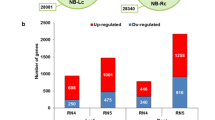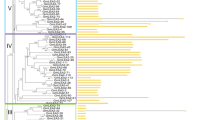Abstract
Plasma membrane intrinsic proteins (PIPs) belong to the aquaporin family and facilitate water movement across plasma membranes. Existing data indicate that PIP genes are associated with the abilities of plants to tolerate certain stress conditions. A review of our Glycine soja expressed sequence tag (EST) dataset revealed that abiotic stress stimulated expression of a PIP, herein designated as GsPIP2;1 (GenBank_Accn: FJ825766). To understand the roles of this PIP in stress tolerance, we generated a coding sequence for GsPIP2;1 by in silico elongation and cloned the cDNA by 5′-RACE. Semiquantitative RT-PCR showed that GsPIP2;1 expression was stimulated in G. soja leaves by cold, salt, or dehydration stress, whereas the same stresses suppressed GsPIP2;1 expression in the roots. Transgenic Arabidopsis thaliana plants overexpressing GsPIP2;1 grew normally under unstressed and cold conditions, but exhibited depressed tolerance to salt and dehydration stresses. Moreover, greater changes in water potential were detected in the transgenic A. thaliana shoots, implying that GsPIP2;1 may negatively impact stress tolerance by regulating water potential. These results, deviating from those obtained in previous reports, provide new insights into the relationship between PIPs and abiotic stress tolerance in plants.







Similar content being viewed by others
Abbreviations
- AQP:
-
Aquaporin
- CDS:
-
Coding sequence
- EST:
-
Expressed sequence tag
- GFP:
-
Green fluorescent protein
- GsPIP21-OXP:
-
Arabidopsis plants overexpressing GsPIP21
- MIP:
-
Major intrinsic protein
- MS:
-
Murashige and Skoog basal salt mixture
- P35S :
-
CaMV35S promoter
- PEG:
-
Polyethylene glycol
- PIP:
-
Plasma membrane intrinsic protein
- RACE:
-
Rapid amplification of cDNA ends
- TIP:
-
Tonoplast intrinsic protein
- WT:
-
Wild type
References
Aharon R, Shahak Y, Wininger S, Bendov R, Kapulnik Y, Galili G (2003) Overexpression of a plasma membrane aquaporins in transgenic tobacco improves plant vigour under favourable growth conditions but not under drought or salt stress. Plant Cell 15:439–447
Anjali G, Ramasubbu S (2009) Genome-wide analysis of major intrinsic proteins in the tree plant Populus trichocarpa: characterization of XIP subfamily of aquaporins from evolutionary perspective. BMC Plant Biol 9:134
Baiges I, Schaffner AR, Affenzeller MJ, Mas A (2002) Plant aquaporins. Physiol Plant 115:175–182
Barkla BJ, Vera-Estrella R, Pantoja O, Kirch H-H, Bohnert HJ (1999) Aquaporin localization-how valid are the TIP and PIP labels? Trends Plant Sci 4:86–88
Boursiac Y, Chen S, Luu DT, Sorieul M, van den Dries N, Maurel C (2005) Early effects of salinity on water transport in arabidopsis roots. Molecular and cellular features of aquaporin expression. Plant Physiol 139:790–805
Chen JX, Wang XF (2006) Manual of plant physiology experiments (published in Chinese). South China University of Technology Press, Guangzhou
Danielson JAH, Johanson U (2008) Unexpected complexity of the aquaporin gene family in the moss Physcomitrella patens. BMC Plant Biol 8:45
Forrest KL, Bhave M (2007) Major intrinsic proteins (MIPs) in plants: a complex gene family with major impacts on plant phenotype. Funct Integr Genomics 7:263–289
Guo L, Wang ZY, Lin H, Cui WE, Chen J, Liu M, Chen ZL, Qu LJ, Gu H (2006) Expression and functional analysis of the rice plasma-membrane intrinsic protein gene family. Cell Res 16:277–286
Jang JY, Lee SH, Rhee JY, Chung GC, Ahn SJ, Kang H (2007a) Transgenic Arabidopsis and tobacco plants overexpressing an aquaporin respond differently to various abiotic stresses. Plant Mol Biol 64:621–632
Jang JY, Rhee JY, Kim DG, Chung GC, Lee JH, Kang H (2007b) Ectopic expression of a foreign aquaporin disrupts the natural expression patterns of endogenous aquaporin genes and alters plant responses to different stress conditions. Plant Cell Physiol 48:1331–1339
Ji W, Li Y, Li J, Dai CH, Wang X, Bai X, Cai H, Yang L, Zhu YM (2006) Generation and analysis of expressed sequence tags from NaCl-treated Glycine soja. BMC Plant Biol 6:4
Kaldenhoff R, Ribas-Carbo M, Flexas Sans J, Lovisolo C, Heckwolf M, Uehlein N (2008) Aquaporins and plant water balance. Plant Cell Environ 31:658–666
Li GW, Zhang MH, Cai WM, Sun WN, Su WA (2008) Characterization of OsPIP2;7, a water channel protein in rice. Plant Cell Physiol 49:1851–1858
Maurel C (1997) Aquaporins and water permeability of plant membranes. Ann Rev Plant Physiol 48:399–429
Murata N, Los DA (1997) Membrane fluidity and temperature perception. Plant Physiol 115:875–879
Quigley F, Rosenberg JM, Shachar-Hill Y, Bohnert HJ (2001) From genome to function: the Arabidopsis aquaporins. Genome Biol 3:research0001.1–0001.17
Sakurai J, Ishikawa F, Yamaguchi T, Uemura M, Maeshima M (2005) Identification of 33 rice aquaporin genes and analysis of their expression and function. Plant Cell Physiol 46:1568–1577
Secchi F, Lovisolo C, Schubert A (2007) Expression of OePIP2.1 aquaporin gene and water relations of Olea europaea twigs during drought stress and recovery. Ann Appl Biol 150:1–5
Siefritz F, Tyree MT, Lovisolo C, Schubert A, Kaldenhoff R (2002) PIP1 plasma membrane aquaporins in tobacco: from cellular effects to function in plants. Plant Cell 14:869–876
Temmei Y, Uchida S, Hoshino D, Kanzawa N, Kuwahara M, Sasaki S, Tsuchiya T (2005) Water channel activities of Mimosa pudica plasma membrane intrinsic proteins are regulated by direct interaction and phosphorylation. FEBS Lett 579:4417–4422
Tournaire-Roux C, Sutka M, Javot H, Gout E, Gerbeau P, Luu DT, Bligny R, Maurel C (2003) Cytosolic pH regulates root water transport during anoxic stress through gating of aquaporins. Nature 425:393–397
Walz T, Hirai T, Murata K, Heymann JB, Mitsuoka K, Fujiyoshi Y, Smith BL, Agre P, Engel A (1997) The three-dimensional structure of aquaporin-1. Nature 387:624–627
Weige D, Glazebrook J (2002) Arabidopsis: A laboratory manual. Cold Spring Harbor Laboratory Press, New York
Wudick MM, Luu DT, Maurel C (2009) A look inside: localization patterns and functions of intracellular plant aquaporins. New Phytol 184:289–302
Zhang Y, Wang Y, Jiang L, Xu Y, Wang Y, Lu D, Chen F (2007) Aquaporin JcPIP2 is involved in drought responses in Jatropha curcas. Acta Biochim Biophys Sin (Shanghai) 39:787–794
Zhang DY, Ali Z, Wang CB, Xu L, Yi JX, Xu ZL, Liu XQ, He XL, Huang YH, Khan IA, Trethowan RM, Ma HX (2013) Genome-wide sequence characterization and expression analysis of major intrinsic proteins in soybean (Glycine max L.). PLoS One 8:e56312
Acknowledgments
This project was supported by the Modern Agricultural Industry Technology System of Sugar Beet (CARS-210101-06), the Science Foundation of Heilongjiang University for Young Scientists (QL201124), the General Program of the Education Department of Heilongjiang Province (12531488), the National Natural Science Foundation of China (30570990), the National Key Basic Research Special Funds of China (2003CCA03500), the Special Program of the National High Technology Research and Development Program of China (2007AA10Z193), the National Major Project for the Cultivation of Transgenic Crops (20082x08004), the Key Research Plan of Heilongjiang Province (GA06B103), and the Innovation Research Group of NEAU (CXT004).
Author information
Authors and Affiliations
Corresponding author
Additional information
The corresponding author is not a member of the Botanical Society of Japan. Subject area that is most relevant to the work(5) Physiology/Biochemistry/Molecular and Cellular Biology.
Electronic supplementary material
Below is the link to the electronic supplementary material.
Rights and permissions
About this article
Cite this article
Wang, X., Cai, H., Li, Y. et al. Ectopic overexpression of a novel Glycine soja stress-induced plasma membrane intrinsic protein increases sensitivity to salt and dehydration in transgenic Arabidopsis thaliana plants. J Plant Res 128, 103–113 (2015). https://doi.org/10.1007/s10265-014-0674-7
Received:
Accepted:
Published:
Issue Date:
DOI: https://doi.org/10.1007/s10265-014-0674-7




